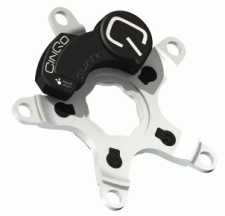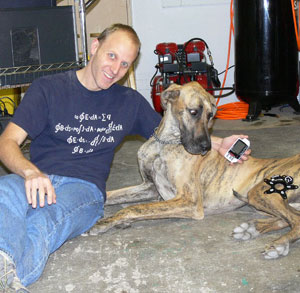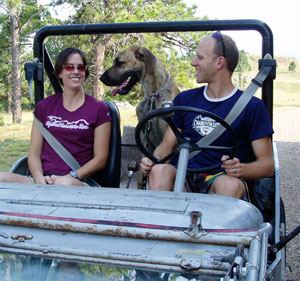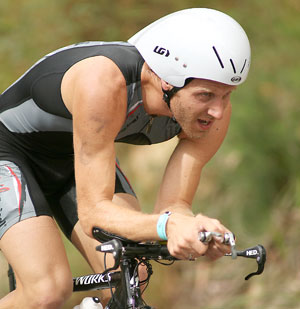You asked for Quarq, we give you Quarq

We have seen quite a bit of interest in Quarq and Quarq Technology on our forum and decided to ask Jim Meyer the man behind Quarq a few questions.
ST: Jim, can you tell us a bit about your engineering background?
Jim: Well, I have always been a hands-on sort of guy. I was always building stuff as a teenager and wrenched in a bike shop. In college I joined the solar car race team and spent far more effort designing and building solar cars than I did on classes. Luckily, I have always had a knack for standardized tests, so I was able to get accepted to graduate school in Mechanical Engineering at MIT. There I worked a bit on hybrid car technology, then did my thesis on race car data acquisition. My office was right next to the Wright Brothers Wind Tunnel, but that was just before they started putting bikes in it, so I never played around over there.
ST: What inspired you to start up Quarq Technology?
Jim: Last year, I had quit my real job and moved to Australia with my wife to train more and find inspiration. I was only over there for a few weeks before I really wanted a power meter, but didn’t like the options. SRM seemed like the ticket, but was way too much money. I realized that my background in bicycles, engineering and data was a good fit, so I dove in.
ST: How big of a team do you have?
Jim: Here at Quarq Technology "World Headquarters" in Spearfish, we have me and Mieke (my wife) and a rotating crew of programmers, MBA friends and interns. Then we have some partner companies that we work with on design and production both here in South Dakota and Australia. Overall there are around 10-15 people that get up everyday and work on our stuff. We will be growing the Spearfish crew as we launch and start providing customer service functions.

ST: What is the operating system and can you give us some other tech specs?
Jim: The Qranium runs a Linux, specifically a variant of Debian. Linux is a free, open source operating system that has widespread support. Nearly all web servers run Linux as well as a growing number of consumer devices including Tivo’s and TomTom GPS units. This is great for everyone because we can build on all the work done by others and also give back to the open source community as we build our application software. Overall the Qranium is much like a PDA built for the bike – graphic display and 512 mb of memory. It is capable of running all sorts of applications – from the basic power and distance readouts to GPS tracks and maps to file analysis and calendars to a web browser and Tetris. Only the basics will be implemented at the start, but this gives you an idea of where we can go.
ST: Which crank sets currently accept the Quarq CinQo instrumented spider?
Jim: FSA Team Issue, FSA Krono, SRAM S900, Truvative Rouleur Carbon, Bontrager Race X Lite, Rotor Agilis, Specialized S-Works Carbon, Cannondale Hollowgram. We are also working on a track version and are investigating additional options.
ST: From what we have read it appears that the Quarq system works via strain gauges. Is this in fact the case?
Jim: Yes. The CinQo utilizes strain gages on the spider. Strain gages are a fairly old technology, and surprisingly simple. Basically it is a grid of wire printed on a little piece of plastic. When you stretch the grid wires, they get a little longer and a little thinner, which increases their resistance. When you compress the grid, the resistance decreases. So that’s it, then you just glue the gage to your part, and you can measure how much it is flexing.
ST: Can you elaborate on the strain gauge configuration?
Jim: The strain gages measure flexing, so in order to make a good torque measurement you need a spider that flexes in a very predictable manner. This is where things get interesting because you have a number of variables at work including the chain pulling in different directions depending on the gear and different chain lines of various crank sets. Our strain gage configuration is the result of lots of Finite Element Analysis and is the subject of our patent. If you want to know more, you will have to buy a CinQo and hack it up. ☺

ST: You have 10 strain gauges, which is more than double the number of gauges in an SRM Pro (4) and 25% more than in an SRM Science (8). How does your system compare in terms of accuracy?
Jim: The accuracy is function of the whole system including the spider shape and structure, number and location of strain gages and the measurement electronics. It would be really easy to build a device with 50 strain gages and have really poor accuracy. It is all a matter of system design. The CinQo will have a comparable accuracy to the SRM and Powertap. The last prototype test I did came in with an average error of 0.25% over the typical operating range. We will be doing more work with the production batches to finalize the accuracy specification. I expect better than 2% over the full torque and temperature range.
ST: Does the unit account for temperature fluctuations during a ride?
Jim: Yes. The strain gage arrangement itself has some intrinsic temperature compensation built in. Additionally, the CinQo has an on-board temperature sensor and can apply a software correction.
ST: How does one recalibrate the zero offset of the unit before each ride?
Jim: We will have a zero offset check built into the Qranium so that it can be easily verified and/or adjusted pre-flight. However, we are working to design out all sources of zero drift such that daily corrections are unnecessary.

ST: The open source software allows developers to write software for it. Do you already have interest along those lines?
The open source aspect of the Qranium has generated much interest. We get regular emails from folks that have ideas and want to participate. And it isn’t just independent bicycling computer geeks, there is academic and commercial interest as well. I think we will see a lot of really neat stuff done. The sky is the limit.
We are working the software now and are committed to making it as absolutely open as possible. The few parts that are closed-source are still very flexible and friendly. We are moving to Python for the high-level operation functions and will be creating a developer’s kit. The One Laptop Per Child project also uses Python. For the high level stuff, it should be fairly accessible – if you are “nerd” enough to do some HTML, you can probably get started with Python on the Qranium.
ST: When will consumers be able to get a hand on the system?
Jim: Ah, the big question. We expect to be shipping first quarter of 2008. People ask if that means Jan or March and we answer “yes”. That’s because we don’t know exactly. The main variables are lead times on component delivery and production scheduling, as well as satisfaction with the final testing and quality control. The last thing we want is to ship a bunch of stuff and then have it come back. So when it comes down to it, we will always delay the release in order to make it right.
ST: Why South Dakota? Sure it is beautiful, but what was the driver behind this location?
Jim: I grew up here in Spearfish. I have lived in a number of other places and traveled all over, but in the end felt this was the place for us to be. The riding is great, the town is beautiful and the commute is 3 minutes. In addition, South Dakota has a very favorable business environment including no income tax, good economic development support and a low cost of living. For us it was a natural choice. In addition, we work with partners all over and will export all over world. So there isn’t really any location that is more central than anywhere else. Give us a broadband connection and Skype and we are in business.

ST: Are you still able to participate in triathlons, or is Quarq Technology all consuming?
Jim: I had a great season last year in Oz and had some good finishes at Noosa and the Gold Coast Half IM. This year was a bit tougher, but I did pretty well for the first half of the year and pulled off 8th in M30-34 at AG Nationals. After that I “tapered” for Interbike. Racing is important to me, so I will be back after it for 2008. I can hear an early spring "business trip" to a cycle camp calling my name. In the end necessity is the mother of invention, so I think Quarq would suffer if we don’t stay involved in the sport.
ST: Where do you see Quarq Technology in 5 years?
Jim: Well, we have an agenda. First off we intend to get very good at making power meters. I think this is a huge growth area in cycling and we are in a nice position to drive it forward. And then, the world of bicycle electronics is very rudimentary at the moment. Bicycles are machines and if you want to optimize the machine you need data. You see this now with everyone going to the wind tunnel. There are lots of things out there that are just waiting to happen if the proper tools are available. We want to round out the toolkit.



